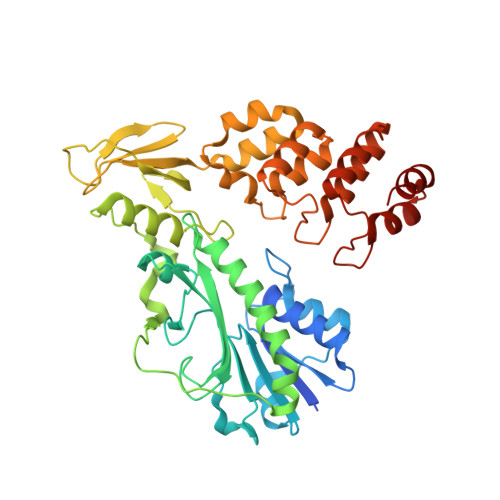New Role for the Ankyrin Repeat Revealed by a Study of the N-Formyltransferase from Providencia alcalifaciens.
Woodford, C.R., Thoden, J.B., Holden, H.M.(2015) Biochemistry 54: 631-638
- PubMed: 25574689
- DOI: https://doi.org/10.1021/bi501539a
- Primary Citation of Related Structures:
4XCZ, 4XD0, 4XD1 - PubMed Abstract:
N-Formylated sugars such as 3,6-dideoxy-3-formamido-d-glucose (Qui3NFo) have been observed on the lipopolysaccharides of various pathogenic bacteria, including Providencia alcalifaciens, a known cause of gastroenteritis. These unusual carbohydrates are synthesized in vivo as dTDP-linked sugars. The biosynthetic pathway for the production of dTDP-Qui3NFo requires five enzymes with the last step catalyzed by an N-formyltransferase that utilizes N(10)-tetrahydrofolate as a cofactor. Here we describe a structural and functional investigation of the P. alcalifaciens N-formyltransferase, hereafter referred to as QdtF. For this analysis, the structure of the dimeric enzyme was determined in the presence of N(5)-formyltetrahydrofolate, a stable cofactor, and dTDP-3,6-dideoxy-3-amino-d-glucose (dTDP-Qui3N) to 1.5 Å resolution. The overall fold of the subunit consists of three regions with the N-terminal and middle motifs followed by an ankyrin repeat domain. Whereas the ankyrin repeat is a common eukaryotic motif involved in protein-protein interactions, reports of its presence in prokaryotic enzymes have been limited. Unexpectedly, this ankyrin repeat houses a second binding pocket for dTDP-Qui3N, which is characterized by extensive interactions between the protein and the ligand. To address the effects of this second binding site on catalysis, a site-directed mutant protein, W305A, was constructed. Kinetic analyses demonstrated that the catalytic activity of the W305A variant was reduced by approximately 7-fold. The structure of the W305A mutant protein in complex with N(5)-formyltetrahydrofolate and dTDP-Qui3N was subsequently determined to 1.5 Å resolution. The electron density map clearly showed that ligand binding had been completely abolished in the auxiliary pocket. The wild-type enzyme was also tested for activity against dTDP-3,6-dideoxy-3-amino-d-galactose (dTDP-Fuc3N) as a substrate. Strikingly, sigmoidal kinetics indicating homotropic allosteric behavior were observed. Although the identity of the ligand that regulates QdtF activity in vivo is at present unknown, our results still provide the first example of an ankyrin repeat functioning in small molecule binding.
Organizational Affiliation:
Department of Biochemistry, University of Wisconsin , Madison, Wisconsin 53706, United States.



















